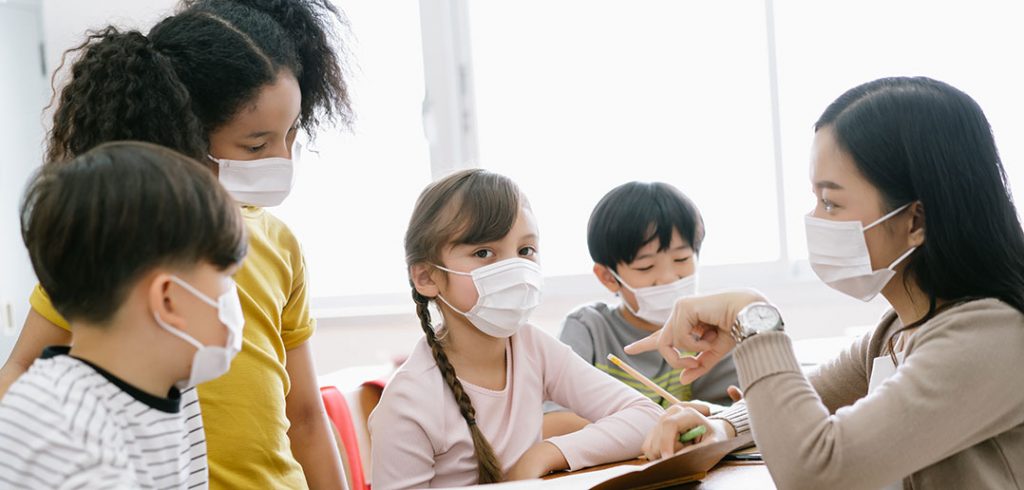After a year of remote learning and hybrid instruction, New York City students are returning to classrooms in person this week. For many, it will be their first time in a school environment in 18 months.
Eric C. Chen, Ph.D., a professor of counseling psychology at the Graduate School of Education (GSE) who oversees the Clinical Mental Health Services in the Bronx Community (CCMH) program, said the key to succeeding will be the individual’s ability to stay flexible and adaptable. The pandemic touched everyone’s lives, he said, but in different and unique ways. How people move forward will depend on many factors.
“It depends on what kind of children you are talking about—their race, ethnicity, where they live, whether they are in public schools or private, whether their parents have the option or privilege to work remotely,” he said, “or things like their housing arrangement—such as whether they have space, multiple rooms, whether they have a caretaker who could help them, or whether they live in multigenerational households.”
Dealing with Trauma
Laura Guy, a psychotherapist in private practice who is the clinic’s outreach/program coordinator, said the clinic’s program staff is acutely aware that even before the pandemic hit, many students in the Bronx were dealing with trauma stemming from racism, poverty, and violence. The clinic offers remote sessions to adolescents in the borough, so it was well-suited to offering help during the lockdowns of 2020.
“These students have had a lot of trauma to begin with, and for the most part, schools were very organizing, safe places to go. When they shut down, that was very hard for many students to deal with,” said Guy.
“They are very resilient families, but everything was thrown into chaos. COVID rates were much higher, in part because their parents are essential workers.”
Robert Garvey, a clinic program assistant and a master’s student in the psychology department, taught high school biology last year and witnessed the challenges students faced.
“The kids who are 14 and 15 became the primary caregivers for their younger siblings. They had to sit with them on Zoom calls for school while also completing their virtual work for themselves,” he said.
“A lot of them took on those family roles even more than they usually would.”
Readjusting to Classrooms
With this history in mind, Garvey suggested that teachers keep their expectations in check for the first few weeks, as students readjust to sitting still at a desk for extended amounts of time.
He knows sometimes teachers feel the pressure to have “30 students who are looking at the board and doing the work.”
“But they might not be ready, right?” he said. “It’s a muscle. They have to build that.”
Another issue that will come up is the fact that for some students, remote learning was a positive experience. Garvey noted that some of his students with special needs got more one-on-one attention than they might have before the pandemic, and Guy said she had students who had been dealing with bullying in school, which was no longer an issue when they were learning at home.
Chen said a good analogy is that every student is like a storybook, and the teacher begins each year with 20 to 30 of them.
“Until I start the first page, I won’t know what the story is about. I want to have time to read all 20 or 30 books, but if I’m too tired, I won’t likely read the book.,” he said.
“So it requires me to have the mental capacity to start that process of getting to know each of the students.”
Chen’s biggest worry is that teachers will get burned out. Self-care, he said, can help prevent what he called “compassion fatigue.”
“Our resilience is like a muscle that we need to exercise on a regular basis, so we need to identify strategies that help us stretch this muscle of resilience, such as doing yoga, riding a bike around the city, or taking the dog for a walk,” he said.
“Teachers need to find a way to monitor their own well-being and know when they seem to reach that tipping point.”
A Role for Parents
Tamique Ridgard, Ph.D., an assistant professor in GSE’s Division of Psychological and Educational Services, said when it comes to advice for parents, communication is key.
“This is definitely a year of major transition for everyone, and we’re all going to have to leave our comfort zones,” she said.
She said she’s optimistic that the tools that enabled students to learn remotely, such as Google classroom, will make it easier for parents to communicate with teachers, and she suggests parents take advantage of the technology if they can.
Ridgard, who works with school psychology interns currently in the system, said the unpredictable nature of the pandemic worries her most. But it’s tempered with an optimism born out of last year’s successes.
“What gives me hope is looking back on the last year and seeing how successfully schools were able to move forward given all the challenges, and from working with my school psychology interns who were in the schools. They still had rewarding experiences during their internships. They worked with a lot of students who were able to make progress,” she said.
Her favorite analogy is that of building an airplane while it’s flying through the air.
“I’ve said that so much over the last year and a half, and I think that’s what we’re going to have to continue to do,” she said.
Chen suggested that parents can help teachers by prioritizing the needs of their children.
“From my perspective, physical health should remain the top priority, followed by mental health and intellectual health,” he said. “Without physical and mental health, the child will not succeed in school.”

